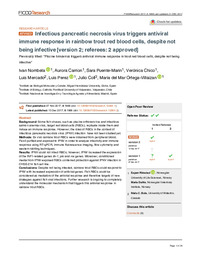Por favor, use este identificador para citar o enlazar este ítem:
https://hdl.handle.net/11000/35039Registro completo de metadatos
| Campo DC | Valor | Lengua/Idioma |
|---|---|---|
| dc.contributor.author | Nombela, Ivan | - |
| dc.contributor.author | Carrion, Aurora | - |
| dc.contributor.author | Puente Marin, Sara | - |
| dc.contributor.author | CHICO GRAS, VERONICA | - |
| dc.contributor.author | Mercado, Luis | - |
| dc.contributor.author | Pérez, Luis | - |
| dc.contributor.author | coll, julio | - |
| dc.contributor.author | Ortega-Villaizan, Maria del Mar | - |
| dc.date.accessioned | 2025-01-20T13:49:30Z | - |
| dc.date.available | 2025-01-20T13:49:30Z | - |
| dc.date.created | 2017-12 | - |
| dc.identifier.citation | F1000Research 2017, 6:1968 Last updated: 21 DEC 2017 | es_ES |
| dc.identifier.issn | 2046-1402 | - |
| dc.identifier.uri | https://hdl.handle.net/11000/35039 | - |
| dc.description.abstract | Background Methods : Some fish viruses, such as piscine orthoreovirus and infectious salmon anemia virus, target red blood cells (RBCs), replicate inside them and induce an immune response. However, the roles of RBCs in the context of infectious pancreatic necrosis virus (IPNV) infection have not been studied yet. : Ex vivo rainbow trout RBCs were obtained from peripheral blood, Ficoll purified and exposed to IPNV in order to analyze infectivity and immune response using RT-qPCR, immune fluorescence imaging, flow cytometry and western-blotting techniques. Results : IPNV could not infect RBCs; however, IPNV increased the expression of the INF1-related genes ifn-1 pkr , and mx genes. Moreover, conditioned media from IPNV-exposed RBCs conferred protection against IPNV infection in CHSE-214 fish cell line. Conclusions : Despite not being infected, rainbow trout RBCs could respond to IPNV with increased expression of antiviral genes. Fish RBCs could be considered as mediators of the antiviral response and therefore targets of new strategies against fish viral infections. Further research is ongoing to completely understand the molecular mechanism that triggers this antiviral response in rainbow trout RBCs. | es_ES |
| dc.format | application/pdf | es_ES |
| dc.format.extent | 26 | es_ES |
| dc.language.iso | eng | es_ES |
| dc.publisher | Taylor and Francis | es_ES |
| dc.rights | info:eu-repo/semantics/openAccess | es_ES |
| dc.rights.uri | http://creativecommons.org/licenses/by-nc-nd/4.0/ | * |
| dc.subject | erythrocytes | es_ES |
| dc.subject | IPNV | es_ES |
| dc.subject | birnavirus | es_ES |
| dc.subject | immune response | es_ES |
| dc.subject | antiviral | es_ES |
| dc.subject | trout | es_ES |
| dc.subject | interferon | es_ES |
| dc.subject.other | CDU::6 - Ciencias aplicadas::60 - Cuestiones generales de las ciencias aplicadas | es_ES |
| dc.title | Infectious pancreatic necrosis virus triggers antiviral immune response in rainbow trout red blood cells, despite not being infective[version 2; referees: 2 approved] | es_ES |
| dc.type | info:eu-repo/semantics/article | es_ES |
| dc.relation.publisherversion | https://doi.org/ 10.12688/f1000research.12994.2 | es_ES |

Ver/Abrir:
F1000 2017 (1).pdf
1,1 MB
Adobe PDF
Compartir:
 La licencia se describe como: Atribución-NonComercial-NoDerivada 4.0 Internacional.
La licencia se describe como: Atribución-NonComercial-NoDerivada 4.0 Internacional.
.png)